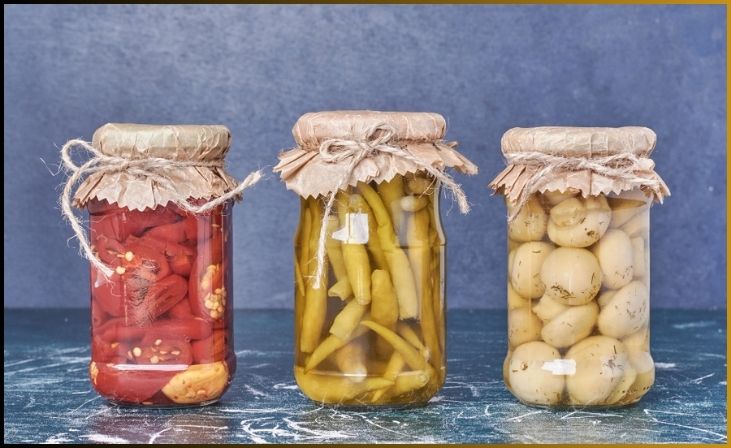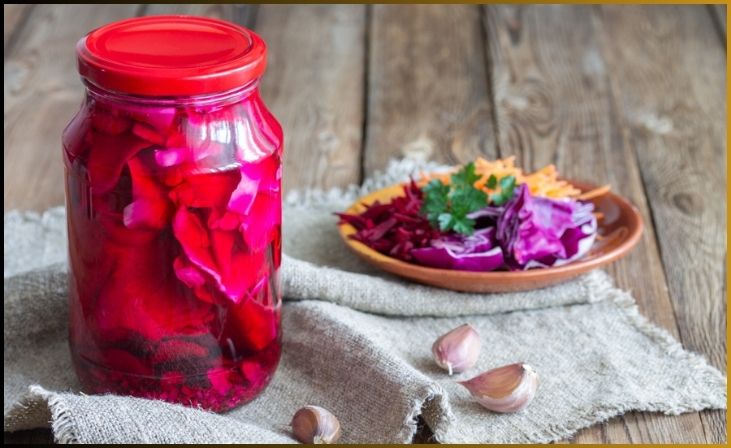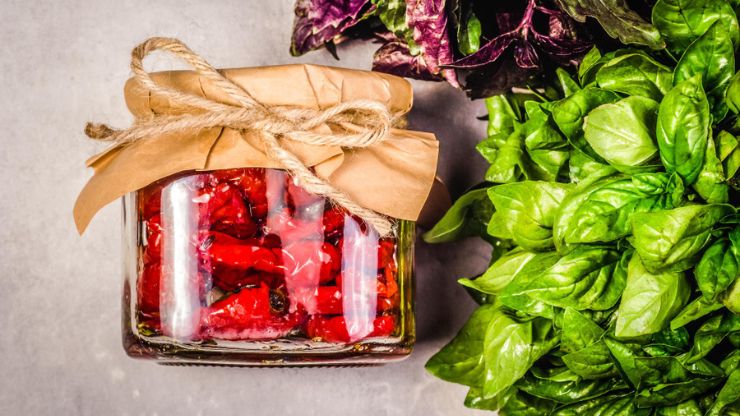Rhubarb is a quintessential spring vegetable, and we are lucky enough to have a large rhubarb plant already growing in the backyard of our new house. It is perennial, which means it will come back year after year without you having to do much to it, and is often one of the first foods that can be eaten from the garden. It is quite sour and is a flavor that often is an acquired taste. I personally love it!
That said, I now have quite a bit of rhubarb on my hands, and when I was looking for ways to use it up, I came across several recipes for fermenting it. I decided that I needed to try this, of course! Most of the recipes call for slicing the ribs up fairly small, but I ran across one for ginger rhubarb pickles that left them in long pieces. I loved this idea, so that’s what I based this recipe for fermented rhubarb on.
I also wanted just a little bit of sweetness to it, so I also added a small about of raw honey, plus a few whole cloves and a whole star anise. I didn’t add any ginger this time, but I’m sure it would be delicious. When I was putting it all together it reminded me of the fermented cranberries that I made last year for the holidays.
Table of Contents
ToggleFermented Rhubarb Recipe
Ingredients:
- 5-6 ribs of rhubarb
- 1-2 Tbsp raw honey
- 1 tsp Himalayan salt, or another non-iodized salt (such as kosher or sea salt)
- 3 whole cloves
- 1 whole star anise
Directions:
Step 1: Selecting Fresh Rhubarb

Selecting fresh rhubarb is a crucial first step in ensuring the success of your fermented rhubarb recipe. Look for stalks that are firm, crisp, and brightly colored, with minimal blemishes or discoloration. The color can vary depending on the variety, but generally, vibrant red or pink hues are desirable. Avoid rhubarb stalks that appear limp or have soft spots.
Larger stalks are often more mature and might have a tougher texture, so aim for medium-sized ones. Freshness is key, as it contributes to the tangy and crisp characteristics that make rhubarb a delightful ingredient. Choosing quality rhubarb sets the foundation for a flavorful and successful fermentation process.
Also Read- How to Make Fermented Green Tomato Salsa
Step 2: Cleaning and Preparing Rhubarb
Cleaning and preparing rhubarb is an essential step to ensure the purity and safety of your fermented rhubarb recipe. Start by rinsing the stalks thoroughly under cold running water to remove any dirt or debris. Trim off the leafy tops, as they contain oxalic acid and are not suitable for consumption. Using a sharp knife, cut the rhubarb into uniform pieces, typically around one-inch in length. Discard the tough or woody ends.
Some recipes may call for peeling the outer layer if it appears stringy, but this is optional. By meticulously cleaning and preparing the rhubarb, you create a clean and consistent base for the fermentation process.
Step 3: Crafting the Fermentation Brine
Crafting the fermentation brine is a crucial step in the process of fermenting rhubarb. Begin by preparing a brine solution, usually consisting of water and salt. The recommended salt-to-water ratio is typically around 2 to 3 tablespoons of salt per quart of water, but this can vary based on personal preference. Ensure that the salt is fully dissolved in the water to create an even mixture.
The brine serves as a medium for fermentation, promoting the growth of beneficial lactic acid bacteria while inhibiting harmful microorganisms. This step sets the stage for the transformation of rhubarb into a tangy and probiotic-rich delight through the process of lacto-fermentation.
Step 4: Adding Flavor (Optional)
Adding flavor to fermented rhubarb is an optional yet delightful step that allows you to infuse unique and complementary tastes. Once you’ve prepared the fermentation brine, consider incorporating various herbs, spices, or aromatics to enhance the flavor profile. Popular choices include ginger, cinnamon, vanilla, or even citrus zest. Experiment with different combinations to find a flavor that suits your preferences.
Don't just scroll, subscribe!
BuzzTrail's unique web-stories are the cure for boredom you've been waiting for.
The infusion of these additional elements during fermentation not only imparts complexity to the rhubarb but also introduces a creative touch to your fermented recipe. This step offers a personalized twist, making your fermented rhubarb uniquely yours.
Step 5: Packing the Jars

After crafting the flavorful rhubarb mixture, it’s time to pack the jars for fermentation. Using clean and sterilized glass jars, carefully transfer the prepared rhubarb along with its brine into the jars. Ensure that the rhubarb is fully submerged in the brine to encourage proper fermentation. Leave some space at the top of the jars to allow for expansion during the fermentation process. Gently press down on the rhubarb to eliminate any air pockets.
This step is crucial for creating an anaerobic environment that supports the growth of beneficial bacteria during the fermentation journey. Tighten the jar lids securely to seal in the flavors and kickstart the fermentation magic.
Step 6: Using Fermentation Weights
In the fermentation process of rhubarb, using fermentation weights is a key step to ensure a successful and controlled fermentation. Fermentation weights are placed on top of the rhubarb within the jar, pressing it down and keeping it fully submerged in the brine. This helps create an anaerobic environment, preventing the growth of unwanted bacteria and mold while promoting the activity of beneficial lactobacilli.
Whether using specialized glass weights or clean stones that fit inside the jar, the goal is to maintain the rhubarb’s contact with the brine, ensuring an effective and flavorful fermentation.
Step 7: Covering with Cloth
After placing the fermentation weights, cover the mouth of the jar with a breathable material like cheesecloth or a coffee filter. Secure it with a rubber band or string to allow air circulation while preventing contaminants from entering. This covering ensures that the rhubarb undergoes a controlled fermentation process.
The cloth acts as a barrier, permitting gases produced during fermentation to escape while safeguarding the rhubarb from exposure to external elements. Maintaining a clean and breathable environment is crucial to the success of the fermentation, allowing beneficial bacteria to thrive and transform the rhubarb into a tangy, probiotic-rich delight.
Step 8: Fermentation Time
Place the covered jars in a cool, dark location to commence the fermentation process. The duration can vary depending on factors like ambient temperature and personal preference, but a typical fermentation period for rhubarb ranges from 5 to 10 days. During this time, the naturally occurring bacteria will work their magic, converting sugars in the rhubarb into organic acids, resulting in a tangy and probiotic-rich product.
Regularly check the rhubarb for signs of fermentation, such as bubbling and a pleasingly sour aroma. Adjust the fermentation time to achieve the desired flavor profile before proceeding to the final steps of refrigeration and enjoying your homemade fermented rhubarb.
For More- How to Make Fermented Ketchup
Step 9: Taste Testing and Refrigeration
Once the fermentation period is complete, it’s time to perform a taste test to ensure the rhubarb has reached your desired level of tanginess. Use a clean utensil to sample a piece, noting the flavor and texture. If it meets your expectations, proceed to the final steps.
Transfer the jars to the refrigerator to slow down the fermentation process. Refrigerating the fermented rhubarb not only halts further fermentation but also enhances its crispness. Chilled and ready to enjoy, your homemade fermented rhubarb can be served as a delightful condiment, added to salads, or incorporated into various culinary creations. Always store the jars in the refrigerator to maintain the freshness and quality of your fermented rhubarb.
Conclusion
In conclusion, crafting your own fermented rhubarb is a rewarding and straightforward process that unlocks a burst of flavors and nutritional benefits. The tangy and crisp result can elevate various dishes, offering a unique twist to your culinary creations. Experiment with different flavor infusions and enjoy the versatility of this fermented treat. By following the simple steps outlined in this guide, you’ll not only savor the distinctive taste of homemade fermented rhubarb but also relish the health benefits of incorporating probiotic-rich foods into your diet.
FAQs
How long does it take for rhubarb to ferment?
How long does it take for rhubarb to ferment?
The fermentation time for rhubarb typically ranges from 5 to 7 days, but it can vary based on factors like room temperature and personal taste preferences.
Can I add other fruits or spices for flavor?
Can I add other fruits or spices for flavor?
Absolutely! Experiment with additions like berries, ginger, or citrus zest to customize the flavor profile of your fermented rhubarb.
Is it normal for the color of rhubarb to change during fermentation?
Is it normal for the color of rhubarb to change during fermentation?
Yes, it’s normal for the color of rhubarb to shift during fermentation. The vibrant red hue may intensify or change slightly due to the fermentation process.

